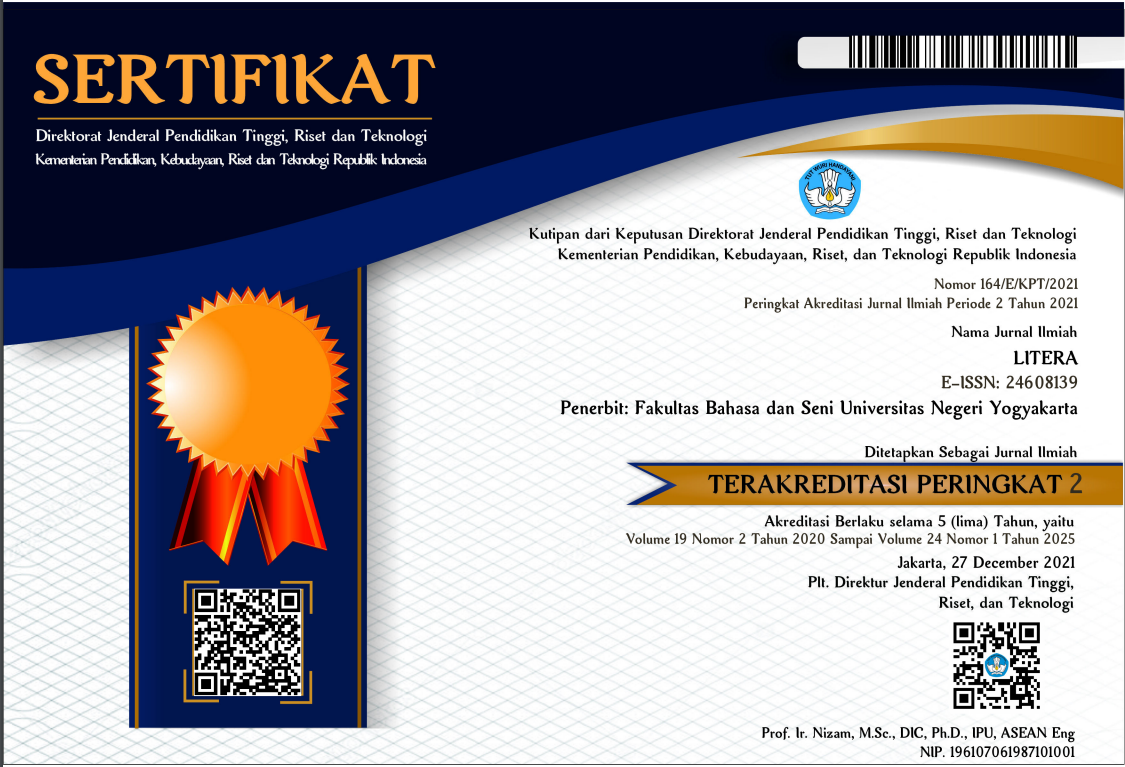Women’s empowerment: Staging power resistance in Oshin (2013)
Geni Kurniati, Universitas Pamulang, Indonesia
Abstract
Fictional movies captivated the audience in many ways through their stories and audio-visual. The stories of fictional movies often reflect what happens to our society, and we savor the purification of the hero’s tragic flaw. One of which is power relations between males and females. This study explores women’s empowerment in Oshin the movie (2013). The narrative is about a seven-year-old girl called Oshin, who is made to work as a maid by her father due to the family’s poverty. At first, she is against her father’s idea of being separated from her family. She struggles to become a maid until she is accused of stealing and runs away. By watching her mother’s efforts as the household pillar, she finally realizes the importance of being an independent female. The movie shows power relations issues regarding filial duty and social stratification. Yet, with the help of Foucault’s theory of The Subject and Power (1982), power resistance is a more eloquent outcome to discuss. Thus, this study proposes the stages of power resistance and how the protagonist declares her resilience through traditional gender roles. Moreover, this study uses an interpretative method by scrutinizing each scene that shows power resistance; the discussion reveals that Oshin participates in staging power resistance for women’s economic empowerment, which subsequently contributes to her family’s economic development. This study concludes that financial independence and women’s empowerment are inextricably linked.
Keywords
Full Text:
PDFReferences
Alkhaled, S. & Berglund, K. (2018). ‘And now I’m free’: Women’s empowerment and emancipation through entrepreneurship in Saudi Arabia and Sweden. Entrepreneurship & Regional Development, 30(7-8), 877-900. DOI: 10.1080/08985626.2018.1500645
Batliwala, S. & Pittman, A. (2010). Capturing change in women’s realities. Association for Women’s Rights in Development (AWID), 1st Ed. Dec. https://www.awid.org/sites/default/files/atoms/files/capturing_change_in_womens_realities.pdf
Biewener, C. & Bacque, M-H. (2015). Feminism and the politics of empowerment in international development. ASPJ Africa & Francophonie, 6(2), 58-75. https://www.airuniversity.af.edu/Portals/10/ASPJ_French/journals_E/Volume-06_Issue-2/biewenerbacque_e.pdf
Bue, C. A., & Harrison, K. (2019). Empowerment sold separately: Two experiments examine the effects of ostensibly empowering beauty advertisements on women’s empowerment and self-objectification. Sex Roles, 81, 627–642. https://doi.org/10.1007/s11199-019-01020-4
Cornwall, A. (2016). Women’s empowerment: What works? Journal of International Development, 28(3), 342–359. J. Int. Dev., 28: 342– 359. Doi: 10.1002/jid.3210. Women's Empowerment: What Works? - Cornwall - 2016 - Journal of International Development - Wiley Online Library
Denzin, K. Lincoln. (ed.). (2017). Qualitative Research (Fifth Edition). Sage Publications, Inc.
Edward, E. R. (2012). Tuning into precious: The black women’s empowerment adaptation and the interruptions of the absurd. Black Camera, 4(1), 74-95. https://www.jstor.org/stable/10.2979/blackcamera.4.1.74
Foucault, M. (1978). The history of sexuality: An introduction. vol I. Pantheon Books.
Foucault, M. (1982). The subject and power. Critical Inquiry, 8(4), 777-795. http://www.jstor.org/stable/1343197
Foucault, M. (1991). Discipline and punish: The birth of the prison. Penguin.
Gilat, A. (2015). “The Courage to Express Myself”: Muslim women's narrative of self-empowerment and personal development through university studies. International Journal of Educational Development, 45, 54-64. https://doi.org/10.1016/j.ijedudev.2015.09.016
Golden, J. (2015). Introducing cinematic and theatrical elements in film. https://dubg8.files.wordpress.com/2015/04/cinematic-techniques-15-pdf.pdf
Hancock, P. (2006). Violence, women, work and empowerment: Narratives from factory women in Sri Lanka’s export processing zones. Gender, Technology and Development, 10:2, 211-228, DOI: 10.1177/097185240601000203
Kabeer, N. (2005). Gender equality and women’s empowerment: A critical analysis of the third millennium development goal. Gender and Development, 13(1), 13-24. https://www.amherst.edu/media/view/232742/original/Kabeer+2005.pdf
Keles, A. (2015). The role of films in literature education at departments of German language and literature in Turkey. Procedia Social and Behavioral Sciences, 197, 652-658. https://www.sciencedirect.com/science/article/pii/S1877042815040471/pdf?md5=aab230bca8b11782381084e20f42e8f8&pid=1-s2.0-S1877042815040471-main.pdf
Kensuke, Z., Nobuyuki, T., & Arimasa, O. (Producers), & Shin, T. (Director). (2013). Oshin [Motion Picture]. Toei Picture.
Lilja, M. & Vinthagen, S. (2014). Sovereign power, disciplinary power and biopower: Resisting what power with what resistance?, Journal of Political Power, 7(1), 107-126. http://dx.doi.org/10.1080/2158379X.2014.889403
Priventa, H., Handayani, U., & Riani, R. W., (2023). Pembentukan polis dan migrasi subjek tokoh Oshin dalam film Oshin karya Shin Togashi (kajian sosiologi sastra perspektif Jacques Ranciere). Kiryoku, 7(2), 46-57. https://ejournal.undip.ac.id/index.php/kiryoku/article/view/55735/24678
Puteri, Y. E., & Widarahesty, Y. (2017). Reproduksi kultural mitos “perempuan ideal” Jepang melalui serial tv Oshin karya sugako hashida tahun 1983. Jurnal Kajian Wilayah, 8(1), 63-74. https://jkw.psdr.lipi.go.id/index.php/jkw/article/view/771
Scherer, E., & Thelen, T. (2021). Following Oshin and Amachan: Film tourism and nation branding in the analogue and digital ages. In N. van Es, S. Reijnders, L. Bolderman, & A. Waysdorf (Eds.), Locating imagination in popular culture: Place, tourism and belonging (pp. 134-150). Routledge.
Valentya, W. K. (2015). Penggambaran peran dan posisi perempuan pada dua keluarga dalam film “oshin” karya shin togashi. Bachelor thesis. https://repository.unair.ac.id/14704/
DOI: https://doi.org/10.21831/ltr.v23i1.68729
Refbacks
- There are currently no refbacks.
______________________
__________________________________________________________________________________________________
Litera Journal is published by the Faculty of Languages, Arts, and Culture Universitas Negeri Yogyakarta in collaboration with Himpunan Sarjana Kesusasteraan Indonesia (HISKI)
The International Journal of Linguistic, Literature, and Its Teaching at http://http://journal.uny.ac.id/index.php/litera/ is licensed under a Creative Commons Attribution-ShareAlike 4.0 International License
__________________________________________________________________________________________________















